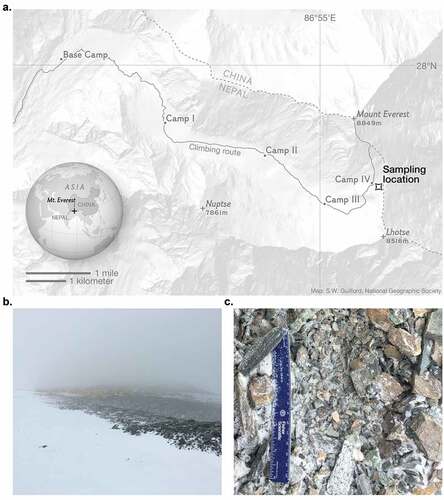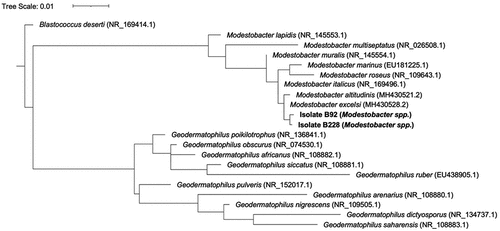Figures & data
Figure 1. The South Col of Mount Everest (27.9728°N, 86.9315°E). (A) Map displaying the sampling location along the Everest climbing route. Samples were collected ~170 m southeast of Camp IV from an exposed surface environment at 7,944 m.a.s.l. (B) View from sampling location back toward Camp IV. (C) The surface at the collection site was made up of fragments of variable grain size, with the smallest fragments <0.5 mm in diameter and the largest fragments ~2-5 cm in diameter. Photo credit: L. Baker Perry/National Geographic.

Figure 2. The microganisms identified in the three South Col samples. (A) The bacterial genera identified through the 16S rRNA gene sequencing and the culturing study. (B) The fungal families identified through the ITS sequencing and the culturing study. (C) The identity of the microeukaryotic ASVs identified through the 18S rRNA gene sequencing. For all heat maps, the number of ASVs (or cultures) assigned with each taxonomic identification is displayed in the corresponding box and colored based on the magnitude. “NA” indicates that a taxonomic classification at that level is not avaliable.

Table 1. Minerological composition of the three South Col sediments.
Figure 3. Modestobacter and Geodermatophilus phylogenetic tree. Phylogenetic relationships displayed are based on partial 16S rRNA gene sequences of at least 800 bp in length. The twenty sequences represented in this tree include two isolates recovered during the culturing study, eight representatives of the genus Modestobacter, and ten representatives of the genus Geodermatophilus, including G. obscurus, the organism isolated from a sediment sample taken at 8,400 m.a.s.l. by the American Everest expedition of 1963. The two cultured Geodermatophilaceae isolates were most closely related to M. excelsi and M. altitudinus, taxa most often associated with cold, dry, high alpine environments like soils of the Atacama Desert and Antarctica. The tree is rooted by Blastococcus deserti, a representative of another Geodermatophilaceae family.

